Working principle and design of indirect water heaters
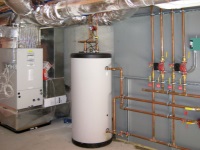
Devices with indirect heating are convenient to use and economical. But before you buy such a boiler, it is desirable to get acquainted with its internal structure and features of work. This will help to determine whether you need such a device and how to choose it correctly.
Features
- The capacity of such a boiler can be up to 500-1000 liters.
- Hot water from such a device comes without interruption and in the right quantity.
- The design of many models provides for additional installation of a heating element for operation in the off-heating season.
- The cost of such a boiler is quite high (mainly because of the complexity of installation), and for installation requires a lot of space, especially if the model with a large capacity.
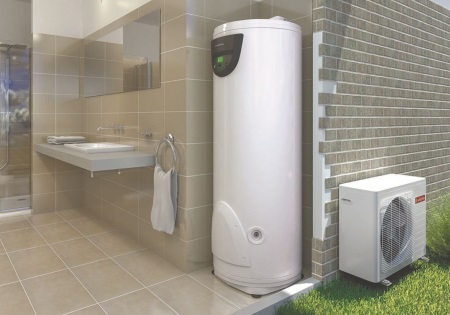
Such a water heater does not need to be connected to the power grid. At the same time, it needs to be connected to a heating boiler or another source of energy, such as a solar panel.
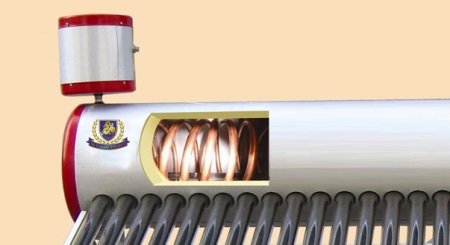
The main elements
In most boilers that function on the principle of indirect heating, the following components are distinguished:
- The outer casing, Which has mounting elements for mounting the device on the wall or on the floor. Most often steel sheet or high-strength plastic is used to make the body. If the model is a floor model, it has support legs that can be adjusted.
- Insulation of the housing. It is an insulating material (for example, polyurethane foam), which fills the space between the body and the tank.
- The tank. It must be resistant to corrosion and constant temperature fluctuations. The most resistant, but the most expensive tank is made of stainless steel. Very common are tanks made of plain steel, which has a protective coating (it can be enamel or vitrified clay).
- Heat exchanger. Usually it is represented by a tubular spiral of brass or steel, which can be installed at the bottom of the tank or evenly occupy the entire internal volume. Some heaters have two heating circuits for connection to different heat sources. Sometimes the heat exchanger is a cylindrical part located inside the tank.
- Safety system. It is usually represented by a safety valve, responsible for the release of too high pressure.
- The thermostat. This part controls the process of heating water in the boiler. It is located in the immersion sleeve inside the tank so that it touches the heat exchanger. Thanks to this placement the thermostat correctly determines the temperature of the liquid heating.
- Magnesium anode. This part protects the internal parts and elements of the boiler from corrosion and rapid deterioration. Since over time it is destroyed, the user will have to replace it regularly.
- Pipes, through which the water enters and exits. At the bottom of the tank of a vertical wall-mounted boiler is a pipe that supplies cold water. It usually has a diffuser, which reduces the turbulence of water flow. Outlet pipe heated liquid is usually located on top. If the boiler is represented by a horizontal model, then such spigots are placed on the right and left. Also left and right connection of the water lines is characteristic for floor devices.
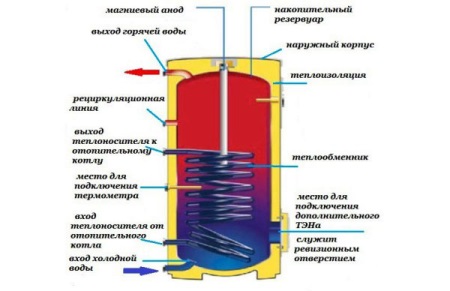
Many models of this type of boilers additionally have such elements:
- Heating element, as well as a thermal relay, necessary for its protection. Such a detail is present in combined boilers, capable of working as a unit of indirect heating, and as a conventional storage heater.
- Recirculation circuit. Its presence in the boiler allows to constantly move heated water inside a separate circuit. Due to this design, it is possible to install a towel warmer on the basis of the device.
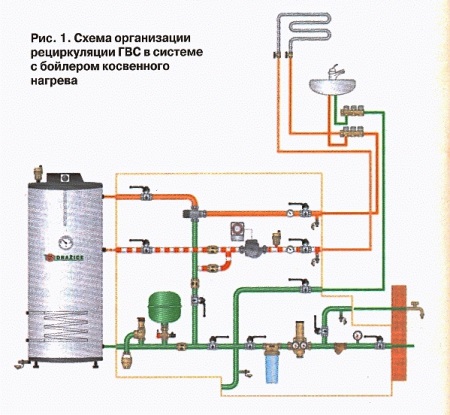
Principle of operation
The basis of operation of the device with indirect heating is the physical phenomenon of heat transfer. It is transferred from the hot coolant, which comes into the boiler from the heating boiler via the inlet pipe and moves inside on a tubular heat exchanger. Part of this heat passes through the walls of the heat exchanger to the water that fills the heater tank from the cold water supply.
How to connect an indirect water heater and why it is necessary, see in the video of Sergey Volkov.




